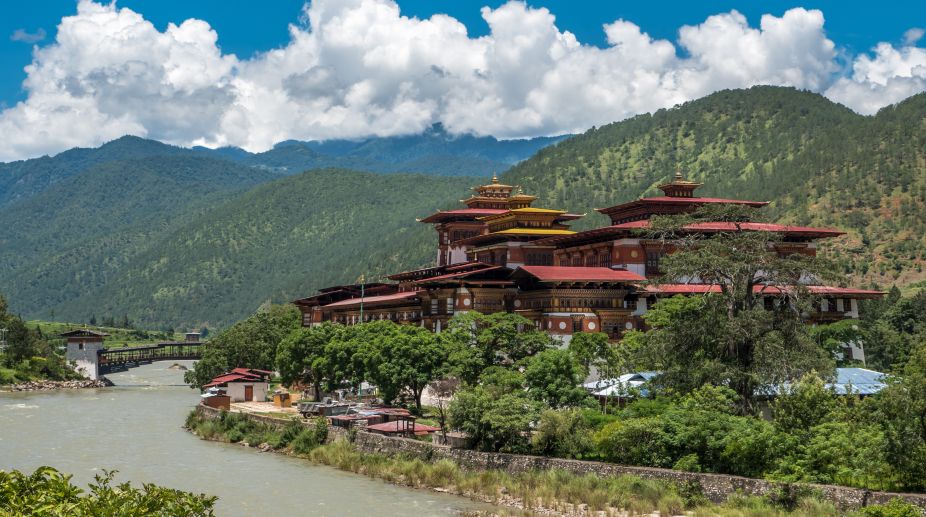PM Modi is an exceptional leader: Bhutan’s King
Calling Prime Minister Narendra Modi an exceptional leader, Bhutan’s King Jigme Khesar Namgyel Wangchuck said India paved the way for a promising and prosperous future under the former’s leadership.

PHOTO: Getty Images
The idea of visiting Bhutan originated from Baljit Singh’s article “Landlocked beauty” in Frontline, 2012. The guiding GNH (Gross National Happiness) philosophy based on sustainable economic development, conservation of the environment, preservation of culture and good governance made me curious about the kingdom.
On the day of Holi, we, a two-family-group, boarded Kanchankanya Express. The train left Sealdah at 8:30 pm and next morning at 11:30 am we got off at Hasimara, the nearest railway station to enter Bhutan from West Bengal. We hired two auto-rickshaws to go to Jaigaon, the border town of India.
We reached Phuentsholing, the border town of Bhutan, a stark contrast to Jaigaon. While the former is pristine, the latter is bleak. To tour that country, an Indian requires Entry Permit from the Regional Migration Office, Phuentsholing. For that purpose one should carry one’s EPIC (original and xerox) and passport-size photograph, in case of a child, birth certificate (original and xerox) and passport-size photograph. Our driver, Ambar, took us to the office. We found the staff very helpful. They were smartly dressed, men wearing gho and women kira. We fell in love with Bhutan at first sight.
Advertisement
After lunch we started for Thimpu, around a 6-7 hours’ drive from Phuentsholing. The quality road and the driver’s skill combined made it a smooth ride. The majestic landscape comprising serpentine roads, streams, rich pine forests, lush green valleys and dazzling peaks mesmerised us. After the evening an air of mystery gripped us. Robert Frost’s poem Stopping by Woods on a Snowy Evening flashed across my mind: “The only other sound’s the sweep/ of easy wind and downy flake.”
We reached Thimpu at 8:30 pm, a picturesque city dotted with dzongs, monasteries and imposing buildings. The next morning at 9 o’clock we went sightseeing around the city. We headed for Tashichho Dzong Fortress located on the west bank of the river Wang Chuu. Apart from the throne room and offices of His Majesty the king of Bhutan, as an administrative building it houses the Central Secretariat and the offices of the ministers of Home Affairs and Finance. The National Assembly is now located in a separate building called SAARC building. We found peach trees in full bloom, creating a riot of colours.
We visited Dechenphodrang, a monastic school, and Changangkha Lhakhang, an old fortress-like temple perched on a ridge. Another religious sight is National Memorial Choeten, a shrine built in memory of king Gyalpo Jigme Dorji Wangchuk called “Father of Modern Bhutan.” Elderly Bhutanese circumambulate the choeten and offer prayers. A visit to the shrine in the evening offers a feeling of peace and serenity.
Takin, the national animal of Bhutan, has a strange appearance with the head of a goat and the body of a cow. The Takin Preserve at Motithang is worth visiting.
To catch a glimpse of Bhutanese art and craft we visited National Institute for Zorig Chusum and its adjacent building Folk Heritage Museum. The Buddha Dordenma Project in Thimpu is going to be the 8th wonder of the world. A 169 ft bronze statue of Buddha has been erected here. The site offers a panoramic view of the capital.
The mountains we saw on the way to Punakha from Thimpu were lush and green. Dochula Pass gave us a serendipitous surprise. It is a popular location among tourists as it offers a panoramic view of the Himalayan mountain range. The view is splendid on clear winter days with snow-capped mountain peaks forming a majestic backdrop to the tranquillity of 108 stupas gracing the mountain pass. Here Druk Wangyal Lhakhang stands as a magnificent architectural work.
We were highly enthusiastic about Punakha Dzong. It is built at the confluence of Pho Chhu and Mo Chhu (rivers) which add to the beauty of the landscape. Puna Mochhu Bazam (bridge) is a part of the attraction of the monastic structure.
We were idyllically happy at Paro. The beauty of its valley is indescribable. We had an exhilarating experience on the bank of Paro river. We could not resist the temptation of dipping our feet into its limpid green water. The surrounding hills offered a sublime view.
Paro airport is one of the wonders of Bhutan. We got to the view point just when a plane was about to take off. It was an unforgettable moment. Next we visited National Museum, an educational institute which interprets history and culture of Bhutan.
A trip to Bhutan remains incomplete without trekking to Taktsang Monastery located on a high cliff towards the north of Paro town. It is associated with the life of Padmasambhava, who is known to have introduced Buddhism to Bhutan.
On our way back to Phuentsholing our driver got us a permit to visit Chhukha Hydro Power Plant. It is a life-time experience. We saw three turbines moving at 350 rpm installed in a forbidden-looking tunnel which goes through a mountain.
The Bhutanese love to live in harmony with nature. It is a clean country with extensive and intact forest cover, clean waterways, scenic landscape and benign people.
Advertisement